Step into the vibrant world of Ikat, an ancient weaving technique that has woven its way into the rich tapestry of Indian culture. Originating from the Sanskrit word 'ikata,' meaning "to bind," Ikat is a meticulous and intricate craft that has been perfected over centuries. In India, the art of Ikat is a testament to the skill and creativity of artisans who bring to life the magic of handwoven textiles.
1. Preparing the Yarn:
At the heart of Ikat lies the yarn, the foundation upon which the entire masterpiece is built. Skilled artisans carefully prepare the yarn, usually made from cotton or silk, ensuring its uniform thickness and strength. The quality of the yarn is crucial, as it determines the final texture and durability of the fabric.

2. Marking the Yarn with Designs:
The soul of Ikat lies in its intricate designs, which are marked onto the yarn before weaving begins. Artisans use a resist dyeing technique to apply the designs onto the yarn. This involves tying sections of the yarn with thread or other materials to create a barrier against the dye. The tied sections remain untouched by the dye, preserving the original color and creating the distinctive blurred patterns that characterize Ikat.
3. Binding the Yarn:
With the designs marked, the next step is binding the yarn. This involves tightly wrapping specific areas of the yarn with materials like wax, plastic, or rubber to protect them from the dye. The precision and care taken during this step determine the clarity and sharpness of the final patterns.

4. Dyeing Process:
The bound and marked yarn is then immersed into vats of natural or synthetic dyes. The bound sections resist the penetration of the dye, creating a beautiful interplay of colors. The dyeing process is repeated for multiple colors, and each layer adds depth and complexity to the final design. The yarn is then left to dry, allowing the colors to set and intensify.

5. Hand Weaving:
After the dyed yarn has dried, skilled weavers take over, meticulously hand-weaving the threads into intricate patterns. The marked and dyed yarn is carefully aligned to ensure the design continuity, and the weaver's expertise is crucial in maintaining the precision of the motifs. The rhythmic clatter of the handloom becomes a symphony, transforming the dyed yarn into a unique piece of art.

To say the least, Ikat weaving in India is not merely a craft; it's a celebration of tradition, skill, and artistry.
The journey from preparing the yarn to the final handwoven masterpiece is a testament to the dedication of artisans who have preserved and elevated this ancient technique. As we appreciate the beauty of Ikat textiles, we also honor the hands that bring them to life, contributing to the continued legacy of Indian craftsmanship.
Process Images Courtesy: Dastkaar Haat Samiti for Google Arts & Education


Leave a comment